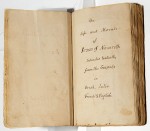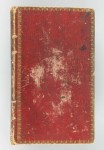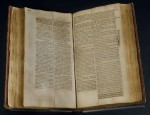 In 1820, when Thomas Jefferson was 77, he scared himself up a Bible. He didn’t write one. He created one by literally cutting and pasting passages from six books of the New Testament in four languages, English, French, Greek and Latin. It wasn’t something he intended to publish or even publicize. Jefferson conceived it as a personal philosophical exploration of deism and Jesus’ ethical system. He called it “The Life and Morals of Jesus of Nazareth” and he intentionally omitted any references to the divinity of Christ, miracles or any supernatural intervention.
In 1820, when Thomas Jefferson was 77, he scared himself up a Bible. He didn’t write one. He created one by literally cutting and pasting passages from six books of the New Testament in four languages, English, French, Greek and Latin. It wasn’t something he intended to publish or even publicize. Jefferson conceived it as a personal philosophical exploration of deism and Jesus’ ethical system. He called it “The Life and Morals of Jesus of Nazareth” and he intentionally omitted any references to the divinity of Christ, miracles or any supernatural intervention.
 He used a razor to clip out passages, then glued them in four columns (one for each language) to both sides of a piece of paper. The final tally is twelve different kinds of paper and seven different inks over 86 pages which were then professionally bound in gold-tooled Morocco leather with a hand-sewn binding. Jefferson kept it his whole life, never gave it away or sold it, and despite his many debts, his heirs kept it in the family for decades.
He used a razor to clip out passages, then glued them in four columns (one for each language) to both sides of a piece of paper. The final tally is twelve different kinds of paper and seven different inks over 86 pages which were then professionally bound in gold-tooled Morocco leather with a hand-sewn binding. Jefferson kept it his whole life, never gave it away or sold it, and despite his many debts, his heirs kept it in the family for decades.
The Smithsonian’s librarian finally purchased the Bible from Jefferson’s great-granddaughter Carolina Randolph in 1895. Nine years later the Government Printing Office made lithographic reproductions of the Bible for distribution to new members of Congress. It was a one-time run, though, and no further copies were made.
 Now, almost 200 years after Jefferson first created his Bible scrapbook, it’s in dire need of restoration. The pages are stiff and inflexible from the glue and clippings, with 90% of them damaged in some way. The binding remains tight, which isn’t a good thing when the pages are so brittle.
Now, almost 200 years after Jefferson first created his Bible scrapbook, it’s in dire need of restoration. The pages are stiff and inflexible from the glue and clippings, with 90% of them damaged in some way. The binding remains tight, which isn’t a good thing when the pages are so brittle.
Conservators have removed the pages from the binding. Once they’re cleaned and stabilized, the pages will be returned to the original binding so that the book can go on display at a proper 90 degree viewing angle. The Smithsonian estimates the restoration will cost $225,000 and are raising money to cover the costs from public and private sources. If you’d like to donate to help preserve the Jefferson Bible, please click here.
The National Museum of American History blog will be posting a series of entries on the conservation, starting with this one. Once the Bible is fully restored, it will be digitally scanned and uploaded for public viewing. There will also be a companion website with more information about the Bible, the conservation process, and Jefferson’s annotations and edits.